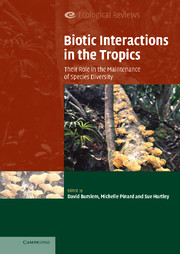Book contents
- Frontmatter
- Contents
- List of contributors
- Preface
- PART I Plant–plant interactions
- PART II Plant–microbe interactions
- PART III Plant–animal interactions
- PART IV Biotic interactions in human-dominated landscapes
- 18 The alteration of biotic interactions in fragmented tropical forests
- 19 Effects of natural enemies on tropical woody-plant invasions
- 20 New mix of alien and native species coexists in Puerto Rico's landscapes
- 21 The dynamics of a tropical dry forest in India: climate, fire, elephants and the evolution of life-history strategies
- 22 Changes in plant communities associated with timber management in natural forests in the moist tropics
- Index
- References
20 - New mix of alien and native species coexists in Puerto Rico's landscapes
Published online by Cambridge University Press: 25 August 2009
- Frontmatter
- Contents
- List of contributors
- Preface
- PART I Plant–plant interactions
- PART II Plant–microbe interactions
- PART III Plant–animal interactions
- PART IV Biotic interactions in human-dominated landscapes
- 18 The alteration of biotic interactions in fragmented tropical forests
- 19 Effects of natural enemies on tropical woody-plant invasions
- 20 New mix of alien and native species coexists in Puerto Rico's landscapes
- 21 The dynamics of a tropical dry forest in India: climate, fire, elephants and the evolution of life-history strategies
- 22 Changes in plant communities associated with timber management in natural forests in the moist tropics
- Index
- References
Summary
‘There is no controversy among scientists that nonindigenous species cause extinctions of native species.’ … ‘The increase in nonindigenous species-induced rates of extinction of native species on both local and global scales is a fact.’
D. M. Lodge and K. Shrader-Frechette 2003, p. 34 and 36‘The evidence so far points to the conclusion that invaders often cause extinction on oceanic islands and in lakes but rarely in the sea or in large land masses.’
G. J. Vermeij 1996, p. 6Introduction
The advent of the Homogeocene (Putz 1997), Homogecene (McKinney & Lockwood 1999; Lockwood & McKinney 2001) or Homogocene (Lodge & Shrader-Frechette 2003) – the era of human domination of the world – is both a challenge and an opportunity to test the ingenuity of humans. Will we be able to establish a new and sustainable balance with the rest of the world's biota? To do so requires active management of biodiversity based on understanding the function and dynamics of ecosystems. Appropriately, the approach to the study of the biota is undergoing a shift from a taxonomic, distributional and evolutionary focus, to a paradigm that considers biodiversity and ecosystem function (Naeem 2002). This new approach is holistic and quantitative, and helpful in understanding the role of biodiversity in the Homogeocene (Lugo 1995, 2002a).
Much of the current literature on tropical biodiversity focuses on the negative effects of non-indigenous or alien species, particularly invasive ones.
- Type
- Chapter
- Information
- Biotic Interactions in the TropicsTheir Role in the Maintenance of Species Diversity, pp. 484 - 509Publisher: Cambridge University PressPrint publication year: 2005
References
- 9
- Cited by



